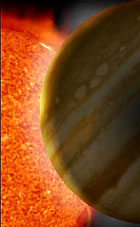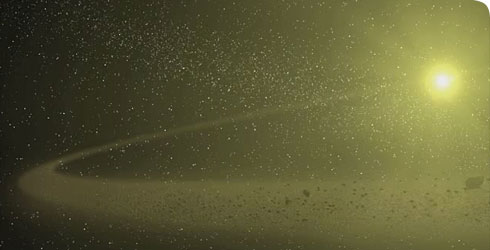Other planetary systems
Whether or not our solar system is the only planetary system in the universe has intrigued scientists and philosophers for hundreds of years. It has only been in the last 15 years that planets orbiting distant stars have been detected. However, we still have not seen these 'extrasolar' planets. So, how do we know they are there?

A giant planet orbiting close to a solar-type star.
Evidence for extrasolar planets
Until recently there was no evidence to suggest that any planets existed around the 100 billion stars in our galaxy, except for around our sun. However, over the last 15 years we have detected evidence of over a hundred planets orbiting other stars, even though they are far too small to be seen by any telescope. We know they are there because of the effect they have on their host star. When a planet orbits a star, its gravity causes the star to wobble. Changes in the wavelength of the light coming from the star can be detected when the star wobbles in the direction of Earth. This change in wavelength is known as the Doppler effect and is similar to the change in pitch of the siren when a police car passes the listener.
Are extrasolar planets like Earth?
Extrasolar planets are different to Earth. They are massive. The biggest we know of is 3,180 times larger than Earth. Even the smallest extrasolar planet is about 30 times larger than our planet. Most also have orbits which are about five times closer to their host star. This means that they must have incredibly high surface temperatures. So far the biggest extrasolar planetary system found is around Upsilon Andromedae, a star 44 light years away that has three orbiting giant planets.
This is not to say that there are no extrasolar systems like ours. Extrasolar planets that are large and close to their host star create a larger and more noticeable wobble. This means their Doppler effect is more easily detected. At present we are not able to detect the Doppler effect for an extrasolar system similar to ours, but it is possible they are out there.
Toolbox

There are 27 km of specimen shelves in the Darwin Centre - the same distance as between the Museum and Junction 6 of the M1.
